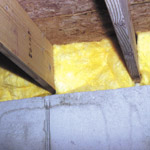blanket insulation
Blanket insulation is the most common and widely available type of insulation; it comes in the form of batts or rolls. It consists of flexible fibers, most commonly fiberglass. You also can find batts and rolls made from mineral (rock and slag) wool, plastic fibers, and natural fibers, such as cotton and sheep's wool.
 |
Batts and rolls are available in widths suited to standard spacing of wall studs, and attic or floor joists. Continuous rolls can be hand-cut and trimmed to fit. They are available with or without facings. Manufacturers often attach a facing (such as kraft paper, foil-kraft paper, or vinyl) to act as a vapor retarderer and/or air barrier. Batts with a special flame-resistant facing are available in various widths for basement walls where the insulation will be left exposed. A facing also helps facilitate fastening during installation. However, it's recommended that you use unfaced batts if you're reinsulating over existing insulation.
Blankets come in rolls of up to 64 feet. Batts are simply blankets pre-cut into 4-foot or 8-foot lengths. Widths are standard 16 inches or 24 inches making these forms of insulation best for wood framing that uses the same dimensions between studs. Thicknesses include 3 inches, 6 inches, and 9 inches, but a 1-in.chversion is available for special applications like around sills and narrow spaces inside masonry walls. The R-value for each of these thicknesses varies with the material. Standard fiberglass blankets and batts have a thermal resistance or R-values between R-2.9 and R-3.8 per inch of thickness. High-performance (medium-density and high-density) fiberglass blankets and batts have R-values between R-3.7 and R-4.3 per inch of thickness. See the table below for an overview of these characteristics.
| Fiberglass batt insulation characteristics | ||
|---|---|---|
| Thickness (inches) | R-value | Cost (cents/sq ft) |
| 3 1/2 | 11 | 12-16 |
| 3 5/8 | 13 | 15-20 |
| 3 1/2 (high density) | 15 | 34-40 |
| 6 to 6 1/4 | 19 | 27-34 |
| 5 1/4 (high density) | 21 | 33-39 |
| 8 to 8 1/2 | 25 | 37-45 |
| 8 (high density) | 30 | 45-49 |
| 9 1/2 (standard) | 30 | 39-43 |
| 12 | 38 | 55-60 |
*This table is for comparison only. Determine actual thickness, R-value, and cost from manufacturer and/or local building supplier.
Installation
The maximum thermal performance or R-value of blanket and batt insulation depends heavily on proper installation. Therefore, it's best to have a certified insulation installer do it. If you'd like to have it done professionally, you should do the following:
To evaluate batt installation, you can measure batt thickness and check for gaps between batts.
If you want to install the insulation yourself, carefully follow instructions and the necessary safety precautions. The insulation's manufacturer may offer instructions. You should also check your local building and fire codes.
Cost
Blanket (batt or roll) insulation and installation usually costs less than other types of insulation.
